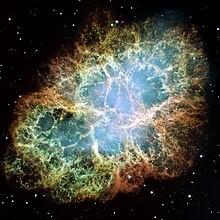
A Crab is a standard astrophotometrical unit for measurement of the intensity of Astrophysical X-ray sources.[1][2][3][4] One Crab is defined as the intensity of the Crab Nebula at the corresponding X-ray photon energy.
The Crab Nebula, and the Crab Pulsar within it, is an intense space X-ray source. It is used as a standard candle in the calibration procedure of X-ray instruments in space. However, because of the Crab Nebula's variable intensity at different X-ray energies, conversion of the Crab to another units depends on the X-ray energy range of interest.
In the photon energy range from 2 to 10 keV, 1 Crab equals 2.4 · 10−8 erg cm−2 s−1 = 15 keV cm−2 s−1 = 2.4 · 10−11 W m−2. For energies greater than ~30 keV, the Crab Nebula becomes unsuitable for calibration purposes, as its flux can no longer be characterized by a single coherent model.[1]
The unit mCrab, or milliCrab, is sometimes used instead of the Crab.
- ^ a b M. Kirsch; et al. (2005). "Crab: the standard X-ray candle with all (modern) X-ray satellites" (PDF). Proc. SPIE, 5898 (2005) 22-33. Archived from the original (PDF) on 2011-07-19. Retrieved 2011-01-21.
Various X-ray satellites have used the Crab as a standard candle to perform their calibrations in the past
- ^ "The Crab Nebula: standard candle no more?". European Space Agency. 2011-01-14. Retrieved 2011-01-21.
These characteristics led astronomers to regard the Crab Nebula as a standard candle, up to the point that fluxes in high-energy astrophysics are customarily measured in units of the Crab's flux.
- ^ "The Crab Nebula Flickers!". Sky & Telescope. 1989-10-20. Archived from the original on 2013-02-02. Retrieved 2011-01-21.
It's routinely used for instrument calibration and even as a unit of measure, the "millicrab." An unexpectedly varying Crab Nebula might have affected any research that used the Crab as a standard or a calibration tool.
- ^ "Specification of Physical Units within OGIP FITS files". NASA. 1995-05-04. Archived from the original on 2011-07-17. Retrieved 2011-01-22.
the 'crab' was commonly used in the early days of X-ray astronomy